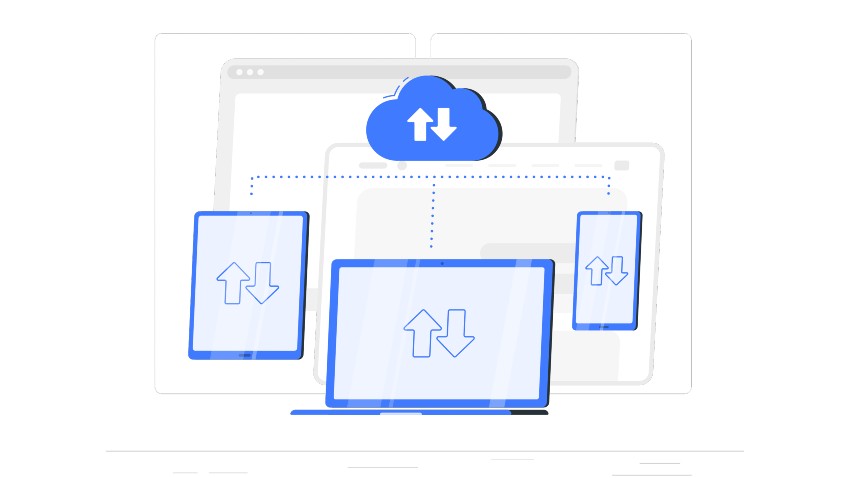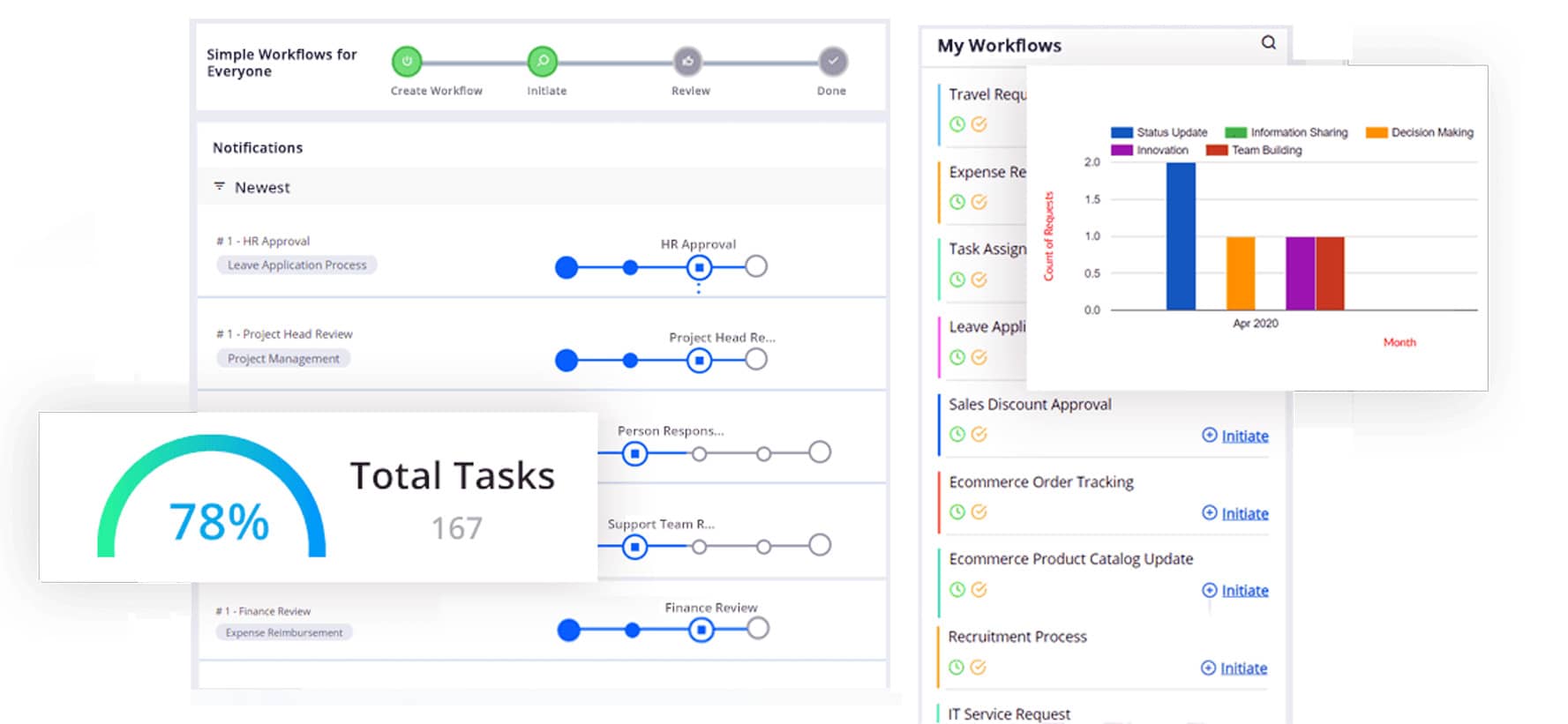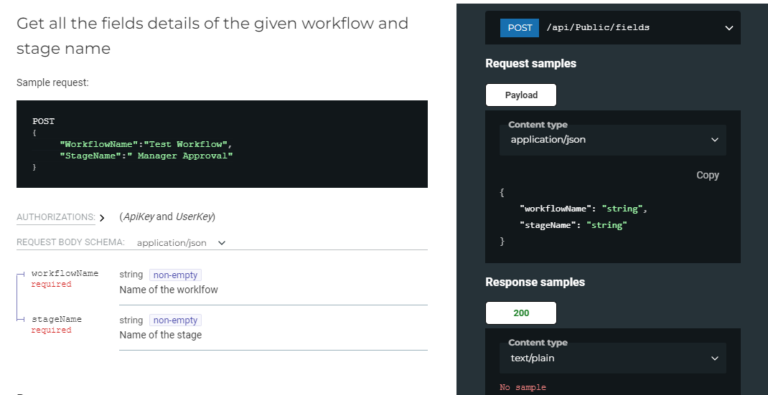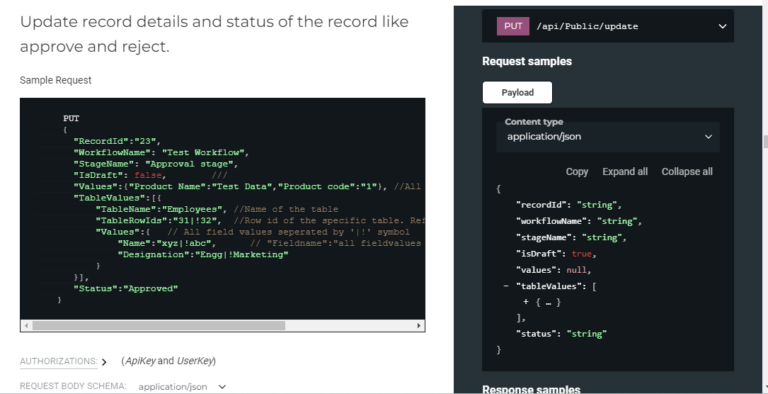Get Started with Workflow API
Cflow’s business automation workflow offers various sets of REST APIs for applications, services, and programming components.


What is an API?
API refers to the acronym for Application Programming Interface. It acts as a connection/interface between software or computers to help communicate, simplify programming, and enable a secure connection.
APIs are essential as they show only the crucial information and actions necessary for development. Using API-based workflows, organizations can achieve enhanced efficiency, reduce manual effort and improve overall productivity.
Workflow API
A workflow API is a set of rules and protocols that allow software applications to interact with and control workflows. The workflow API provides a standardized way for developers to integrate workflow management capabilities into their applications.
Workflow API facilitates the interaction between the process instances and provides auxiliary functionalities for the workflow server. These functionalities include working with users, managing timers within the server instance, stopping timers in the server, etc. With the help of workflow API, developers can effectively communicate with process instances and enable tasks such as user management and timer control.

REST API Workflow
One popular type of API workflow is the REST API Workflow. Representational State Transfer (REST) is an architectural style that provides a set of guidelines for building web services. REST APIs enable developers to interact with web-based resources by using standard HTTP methods such as GET, POST, PUT, and DELETE. With REST API workflows, you can easily create, update, and manage data across multiple platforms and systems.

Cflow’s Workflow API
Cflow uses REST API protocol. The REST API provides a way to connect with external applications and update their data in Cflow’s process automation engine. REST API is part of Cflow’s integration framework that you can use to integrate external applications with the process automation engine applications. All your business objects and integration object structures will be stored as REST API resources. This resource data will be available in either JSON or XML format. External applications can then use the REST API to update their application data.
REST API Framework
Cflow’s workflow API is built using .net C# methods. It can be called from any application to create a workflow, create records, and edit and approve records in Cflow. You can use the REST API resources without any configuration for integrations. The REST API supports standard HTTP GET, POST, PUT, and DELETE methods for query, create, update, and delete operations on resources.
Authentication
You need an API key, User Key, and Username to authenticate requests. You can authenticate by logging into Cflow and navigating to
Dashboard => Admin => API Settings => Get API key.
To get the User Key, navigate to Profile => API Key => UserKey. You will need these request parameters at the end of every endpoint for authentication.
GET method
You can use the GET method, where you can use a unique identifier of the specific object resource or workflows that you want to retrieve. You need to use appropriate authentication headers and other parameters specified by the Cflow API documentation.

POST, PUT, and DELETE methods
You can use HTTP POST, PUT, and DELETE methods to modify the resources. You can use the PUT method to update an existing resource; the POST method to create a new resource; and the DELETE method to delete specific resources. You must use appropriate authentication headers and other parameters specified by the Cflow API documentation.


API Responses
Cflow’s API calls can be identified with the help of the HTTP response codes. You can identify the status of the API call with the help of these server responses:
- 200 - Success
- 400 - Bad request
- 500 - Internal server error
- 404 - Workflow doesn’t exist
- 401 - Unauthorized request
Security, Permissions, and Customization
Cflow’s process automation engine will provide the required authentication layer and authorization security for the APIs. Also, you can customize the APIs to represent different resources by changing their structural attributes.
In Cflow, API permissions align with the permissions granted to users in the Cflow interface. This means that if a user has a certain permission to perform an action in the Cflow interface, they will also have the corresponding permission to achieve the same action through the API. Any restrictions or permissions granted or revoked for users in the interface will be reflected in their ability to perform similar actions via the API.
Please refer to the Cflow API documentation for detailed information on the available permissions and their corresponding API functionalities.
Workflow API Integration

Using Zapier, you can connect Cflow with thousands of apps to automate your work effectively. This will help you focus on other important tasks, and it is ultimately code free.
To start using Cflow Zap, you need to connect your Cflow account and enter your Cflow API key, which you can generate by logging into your Cflow account, and under API settings, you will find the “Generate API key” which you can copy from your Dashboard. Now paste the API key into your Zapier account and successfully connect it.
For instance, you can instantly connect Cflow with Pipedrive, a sales pipeline, and CRM software. You can choose any number of triggers and actions based on your automation needs.
After connecting Cflow with Pipedrive, you can set any kind of trigger and action you want. For instance, when a new request is triggered, you want a new activity to be created in Pipedrive. Zapier will test the connection and fetch sample data from Cflow to ensure the trigger works correctly when the connection is established.
You can choose a trigger app, which is the app that initiates the workflow. Select Cflow as the trigger app and configure the trigger event based on your requirements, such as creating a new request in a workflow. Then, you can choose Pipedrive CRM as the action app, which is the app where you want to perform an action based on the trigger. Select the specific action you want to take in Pipedrive CRM, such as creating a new deal or updating an existing contact.
Authenticate your Pipedrive CRM account to Zapier and map the data from Cflow’s trigger to the corresponding fields in Pipedrive CRM. This step ensures that the data is transferred accurately between the two systems.
Once the test is successful, you can enable the Zap, and now whenever the trigger event occurs in Cflow, Zapier will automatically perform the action in Pipedrive CRM. This course of action can be customized to suit your business needs better.
Cflow can be easily integrated with various different apps such as Google Sheets, Slack, Quickbooks, MeisterTask, MySQL, HubSpot, Airtable, and thousands more.
Why Cflow’s Workflow API?
Our APIs offer a wide range of advantages for businesses:
Automation
With workflow API, you can easily automate repetitive tasks, which will help you to focus on more critical aspects of your business. By eliminating manual processes, you can save time and reduce errors.
Integration
APIs enable seamless integration between different systems, applications, or platforms. You can connect various tools and services, promoting data consistency and improving overall efficiency.
Customization
Our Workflow API provides flexibility and customization options. You can design workflows tailored to your specific business needs and requirements, ensuring optimal results and outcomes.
Scalability
Our workflow APIs are highly scalable, allowing you to handle increasing volumes of data and processes as your business grows. You can easily add or modify workflow steps as needed.
Real-time Collaboration
Cflow APIs facilitate real-time collaboration between teams and stakeholders. Connecting different applications through workflow APIs enables seamless data sharing and communication, enhancing productivity and collaboration.
Streamlined Processes
API workflows streamline complex business processes by automating data transfer, synchronization, and task execution. This results in improved operational efficiency and reduced manual errors.
Harness the potential of Workflow APIs to revolutionize your business processes.
Our comprehensive API documentation and developer resources empower you to integrate, automate, and optimize your workflows effectively.
Explore our API today and experience the seamless integration, enhanced productivity, and efficiency it brings to your business. Contact our team to learn more and get started on your API-driven workflow journey.
